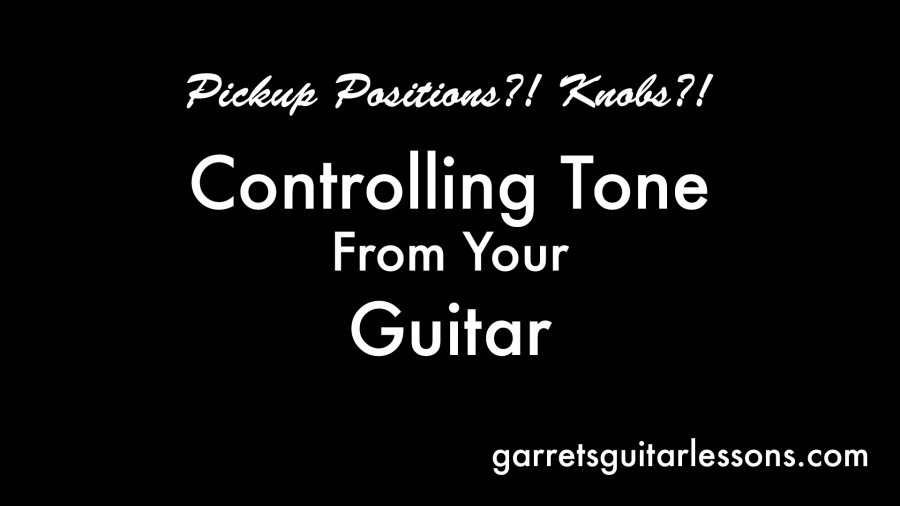Your electronic guitar has pick ups. They are literally magnets that “pick up” the sound your strings are making. To understand how guitar pickups work, let’s look at the various parts of the guitar and the sounds it naturally produces.
The “bridge” is where your strings harness to the guitars body, it is towards the “butt” of the guitar and is typically around where the knobs of your guitars are. So the Bridge Pickup, is the one closes to the bridge. Now with the guitar unplugged, strum as close the bridge as possible, what kind of sound does it make? It is naturally way brighter than strumming in the middle. This is a natural characteristic of the bridge and so the bridge pickup tends to be the brighter pickup.
The neck is where your frets are, so the neck pickup is closest to the neck. Again, with your guitar unplugged, strum your guitar literally on the neck (21st fret or wherever). You’ll notice it is a lot warmer than strumming on the bridge. This is a natural characteristic of strumming on the neck, so the neck pickup tends to be warmer.
The middle is… you guessed it… in the middle. Not closest to the bridge or closes to the neck, just in the middle. This one tends to not be real warm or real bright, I tend to think of it as a bit “throatier” then the other two positions.
Now this is just trying to set up some natural characteristics of the pickups. I am not saying that “brighter” is better, or “warmer” is better, or “throatier” is better, they’re all just different. Each pickup as it’s own place.
Strat | 3 pickups | 5 way Switch
Switch all the way down (Position 1) – Bridge Only
**It’s tough communicating the pickup selector via text, so I’ll be referring to “down” as toward the floor if you’re sitting with your guitar and “up” as toward you.
This tends to the brightest, due to the fact that it’s right next to the bridge. If you’re using distortion, this tends to be preferred. Great for leads, rock and country.
Switch notched one up (Position 2) – Bridge + Middle
These mixed positions tend to be funky sounding and have a type of “quack” that sounds great for a lot of genres. This one is great for clean rhythms, blues and light-medium overdrive.
Switch notched one more up (Position 3) – Middle Only
The pickup position I wish was used more. This is where a lot of the Hendrix and SRV tones came from, although people mostly associate them with Positions 2 and 4, they both used the middle a ton. I tend to think of the middle as the bluesiest of all them. Love the throat-y character of it and tends to be awesome for blues leads and rhythms, and classic rock leads and rhythms. It’s bright enough to cut through on leads, but warm enough for rhythms.
Switch notched one more up (Position 4) – Middle + Neck
Another funky, quacky one, but you’ll notice this one is warmer than position 2. This is due to the middle being mixed with the neck and not the bridge. Another one that’s great for clean, and light-medium overdrive.
Switch noteched all the way up (Position 5) – Neck Only
This is the warmest and tends to be used a lot for jazz and other clean tones. This is good for leads too, just not a cutting lead tone.
Knobs: 3 – Volume (for all pickups), Tone (typically the neck), Tone (typically the middle) The tone knob functions vary from guitar to guitar though.
Les Paul | 2 Pickups | 3 Way Switch
Switch all the way down (position 1) – Bridge Only
Much like it’s single coil counterpart, the bridge is the brightest. Being a humbucker it tends to be thicker sounding. Great for rock, blues, and lead guitar.
Switch in the middle (position 2) – Bridge + Neck
Another funky, quacky one. Jimmy Page used this one a lot so it sounds good with overdrive and this one always reminds me of the Meters clean tone. A nice in between for the bright bridge and warm neck, just be aware of that quack!
Switch all the way up (Postion 3) – Neck Only
Warmest of the three positions available, again much thicker than it’s single coil counterpart. Excellent for rhythms or darker sounding leads.
Knobs: 4 – Volume (Furthest up is for neck pickup), Tone (furthest up is for neck pickup), Volume (furthest down is for bridge pickup), Tone (fursthest down is for bridge pickup)
Tone knob
– A lot of players use this all the way to 10, but if you turn it all the way off, strum a chord then move it up. You’ll notice a “wah” type effect can be acheieved. The tone knob essentially darkens the tone giving you some great in betweens for all sorts of pickups!
Volume knob
Volume know swells are cool, turn the volume knob all the way off, strum a chord then move it up. You hear this gradual build to the chord without hearing the attack of the pick… pretty neat!
You can also use the volume knob as a way to control how much distortion you have. Turn on a farily dirty tone, and move the volume knob to around 2-4, you’ll notice it’s quite a bit cleaner! Turn it up to around 6-7 and it’s a distorted tone, all the way up and you’ve essentially given yourself a lead boost!
These are just starting points to using all the stuff on your electric guitar. Without any pedals and one tone on an amp, you can get a wide variety of tones just using the knobs and pickup selector on your guitars! Also, these are generalizations, you can use these for all sorts of tones and genres.

